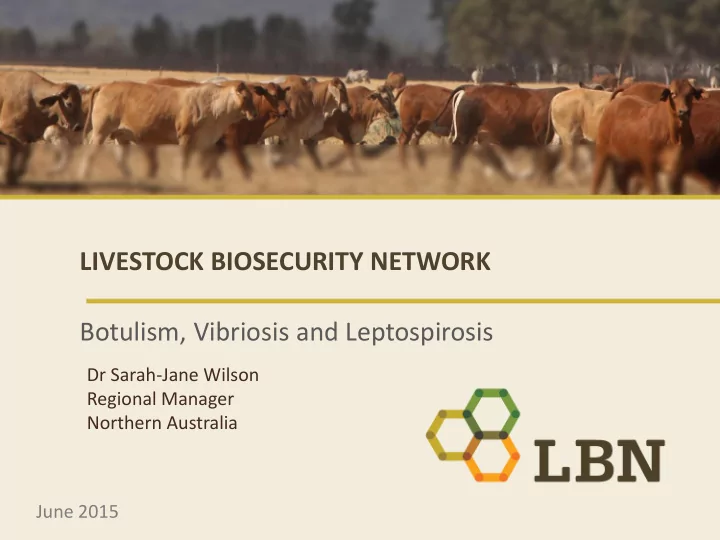

LIVESTOCK BIOSECURITY NETWORK Botulism, Vibriosis and Leptospirosis Dr Sarah-Jane Wilson Regional Manager Northern Australia June 2015
Poll time – Do you currently vaccinate??
Botulism • Clostridial bacteria • Can form spores which are environmentally stable in many conditions • Produces a neurotoxin (affects nerves) • Cattle, sheep, horses, pigs, horses, goats, poultry and humans can all be affected • Preventable, but difficult (and very unproductive) to treat • Predisposition to bone/carrion chewing can increase risk of disease occurrence in unvaccinated livestock (Northern Aus).
Clinical signs • Sudden death • Ascending flaccid paralysis • Drooling • Trouble swallowing • Often lie with head turned to flank
Vaccination protocols for botulism Sheep and cattle: Traditional protocol: • 2 doses (4-6 weeks apart) • Yearly booster Cattle only alternative options: • Single initial dose • 1-3 yearly booster depending on product
Other preventative measures Keep aggregation areas and watering points free from bones and carcases Protein and phosphorus supplementations may help reduce predisposition to bone chewing Provide good quality silage/hay free from contaminants (Fodder vendor declarations)
Questions???
Vibriosis/Campylobacteriosis Cattle • Venereal disease (mating or AI) • Bulls – bacteria present in prepuce, penis and semen • Cows – Reproductive tract Sheep • Spread by ingestion of contaminated water or feed (placental/aborted material, faeces)
Clinical signs Cattle: • No obvious signs in bulls • In cows – abortion and infertility • Cows returning to oestrus • Low conception and/or calving rates Sheep: • Abortions • Extended breeding season. • Low lambing rates • Poor milk supply • Weak and dying lambs
Prevention * Vaccinate bulls (and cows) annually (2 shot initial course) * Vaccination should be given 4 weeks before joining. * Use CHS to demonstrate pre-purchase vaccinations in bulls * Culling older bulls Vaccination regimes: 1. Do not vaccinate 2. Vaccinate all bulls 3. Vaccinate all heifers 4. Vaccinate all bulls and heifers 5. Vaccinate all bulls, heifers and cows.
Estimated annual economic cost of the priority diseases for cattle in Australia MLA disease prioritisation study: Source: Lane et al (2015), p6.
Vaccination options: Sheep 1. Maiden ewes 2. Ewe lambs if joining them 3. Annual booster to adult ewes on stud properties. Initially 2 doses 4 – 6 weeks apart pre joining, yearly booster (for studs)
Prevention: Running maiden ewes with older ewes before mating (for exposure) Protect water supplies from contamination Biosecurity measures for introduced animals • pre-purchase vaccinations, • induction protocols including quarantine, • predator control.
Questions??
Leptospirosis • Over 200 strains of Leptospira Zoonotic disease risk!! • Bacteria colonise the kidneys (m+f) • Also in reproductive tract (f) • Shed in urine, after birth and aborted materials
Clinical signs Cattle Sheep • Sudden death • Fever • Redwater • Anaemia and jaundice • Fever • Abortions/peri-natal deaths • Jaundice • Milk drop • Mastitis and milk drop • Abortions
Prevention and control • Vaccination (Singular or combined products) • Avoid shared contaminated and/or water sources • Prevent contact with wildlife • Avoid access to wet & boggy areas/post-flooding • Implement biosecurity strategies (AHS)
Questions??
POLL – DO YOU HAVE THE EMERGENCY ANIMAL DISEASE HOTLINE NUMBER IN YOUR MOBILE PHONE OR IN A PROMINENT PLACE AT HOME? 1800 675 888
Other resources on vaccinations http://www.mla.com.au/mbfp/Herd-health-and-welfare/Tool-62-Cattle-disease- vaccines http://www.makingmorefromsheep.com.au/healthy-contented-sheep/index.htm FutureBeef – https://futurebeef.com.au/knowledge-centre/husbandry/vaccinations- for-beef-cattle/
Photo credits and references Slide 3: http://www.britannica.com/science/campylobacteriosis Slide 4: www.africavet.co.za; www.abc.net.au; www.old.elensburg.com; www.sheep101.info Slide 5 :www.imgkid.com; Slide 6: Fitzpatrick,S. (2006) Botulism Poisoning in Cattle in the Northern Territory, viewed online at http://www.nt.gov.au/d/Content/File/p/Anim_Dis/651.pdf; https://cattleproducer.wordpress.com/category/animal-welfare-2/page/3/; http://www.infonet-biovision.org/default/ct/671/animalDiseases Slide 8: www.Britannica.com/science/campylobacter Slide 9: http://www.slideshare.net/schoenian/parturition; www.vetnext.com Slide 10: www.cattletoday.com Slide 11: Lane et al (2015), Priority list of endemic diseases for the red meat industries. Meat and Livestock Australia, Sydney. Slide 13: Lane et al (2015), Priority list of endemic diseases for the red meat industries. Meat and Livestock Australia, Sydney. Slide 14: www.thesentimentalbloke.com Slide 16:http://www.britannica.com/science/Leptospira; www.dairy.edu.au Slide 17: http://alonso-amelot.yolasite.com/english.php; www.vetsonline.com
Recommend
More recommend